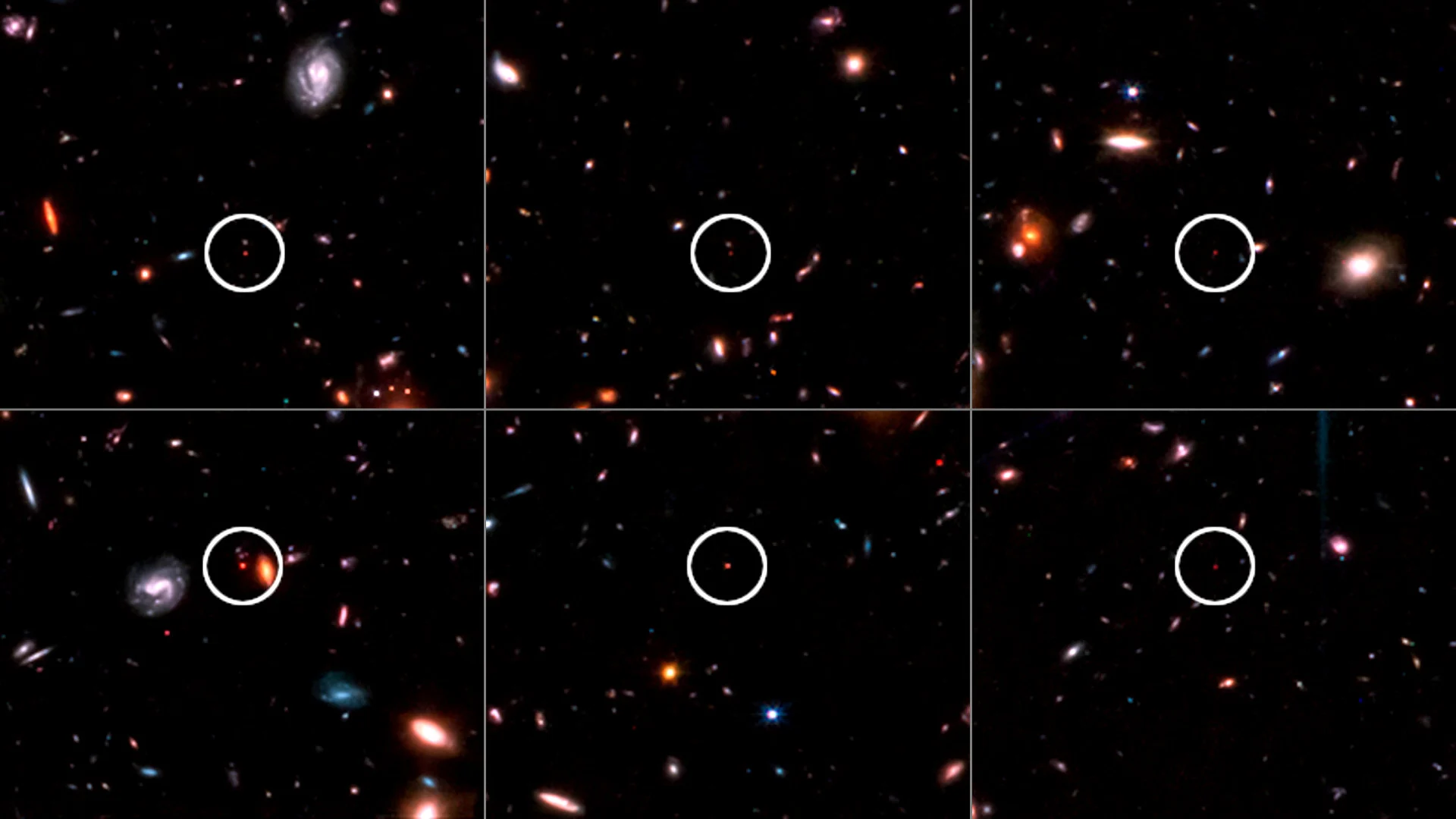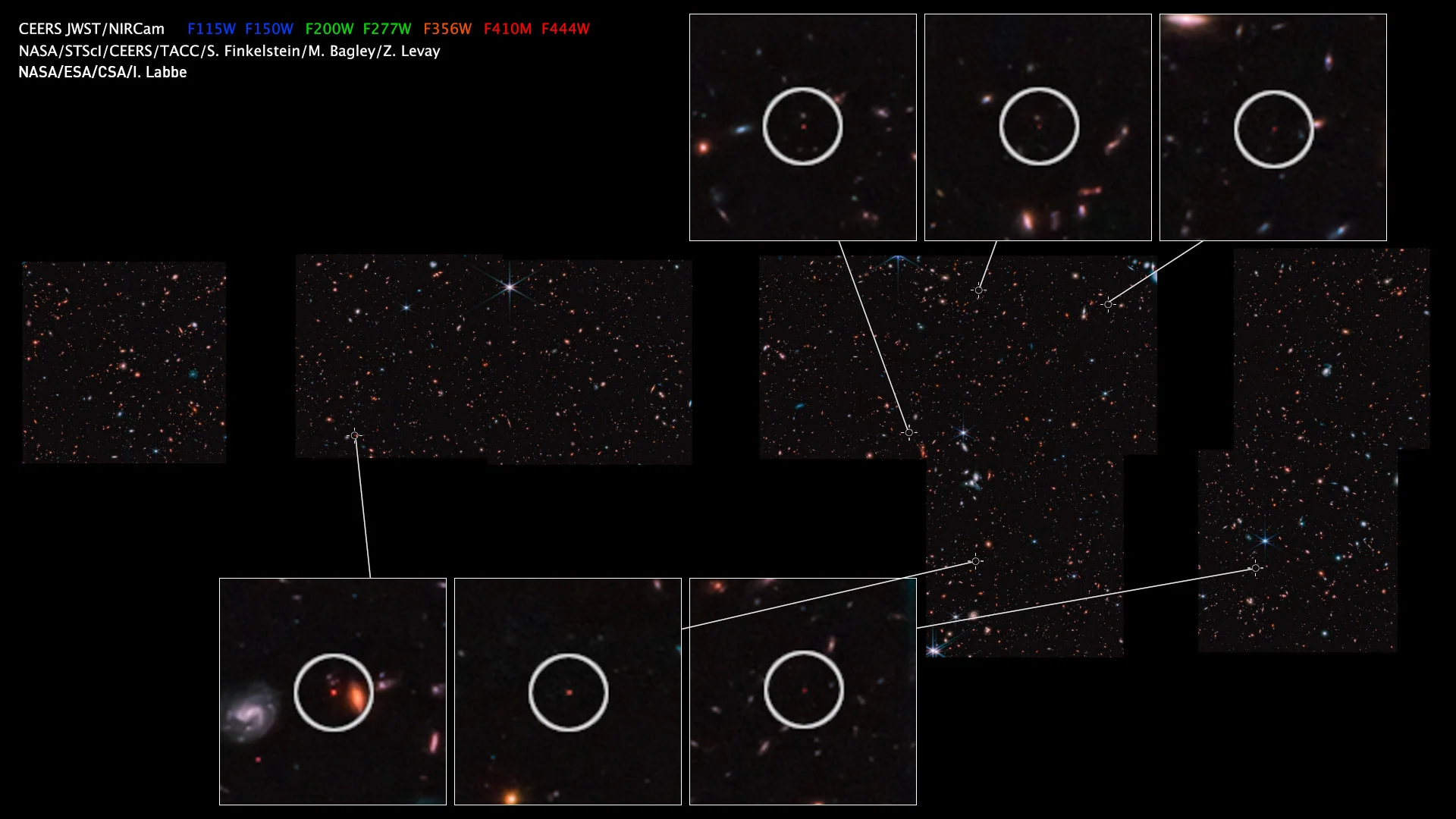
JWST may have spotted "impossibly massive" galaxies in the early universe
The tiny red dots in these images are galaxies seen by the James Webb Space Telescope that appear far more massive than they should be.
The discovery of "giant baby galaxies" could transform our understanding of how the early universe formed.
The James Webb Space Telescope is revealing the cosmos to us like no telescope has done before. So far, it is taking some of the clearest and most detailed images of known objects in our universe. Additionally, astronomers are using it to look farther back in time than we've ever seen.
This is providing an unprecedented look at what the early universe was like, and one team of researchers has just discovered something remarkable.

This composite image shows JWST's CEERS survey results, along with a closeup of each of six early galaxies that appear to be very unusual. Credits: NASA/STScI/CEERS/TACC/S. Finkelstein/M. Bagley/Z. Levay; NASA/ESA/CSA/I. Labbe
The above images were captured in June of 2022, during JWST's Cosmic Evolution Early Release Science (CEERS) survey, as the telescope was pointed to a small region of apparently empty space near the Big Dipper. The six inset images each contain a galaxy (circled) which appears to be one of the earliest to form in the universe. JWST is seeing these galaxies as they would have looked roughly 500-800 million years after the Big Bang.
Astronomers verify the age of galaxies like these by looking at how red they appear. The light from these objects has been travelling through the universe for billions of years to reach us. Since the universe has been expanding all that time, the wavelength of the light has expanded along with it. This has caused the wavelength of the light to shift towards the red and infrared end of the spectrum. JWST is designed to capture different wavelengths of infrared light, and when the data is combined to produce images, the shortest wavelengths show up in blue and the longest wavelengths are in red.
For the farthest and oldest objects, their light has been travelling so long that it is shifted far enough into the infrared that they only show up at the longest wavelengths JWST can capture. Thus, to find them, you need to look through the data for anything that is completely invisible at all of the wavelengths except the longest ones. In images like the one above, these are the galaxies that show up as the deepest colour of red.
Now, based on what astronomers and astrophysicists have figured out about the universe so far, these ancient red-shifted galaxies should be fairly low-mass. After all, a galaxy the size of the Milky Way, with its roughly 100 billion stars, takes several billion years to grow to that size and mass.
Or so we thought?
According to a paper published this week in the journal Nature, the six galaxies found by the research team are not only some of the oldest in the CEERS survey data, each appears bright enough to match the size and mass of the Milky Way!
"It's bananas," Erica Nelson, the University of Colorado-Boulder astrophysicist who co-authoured the new research paper, said in a statement. "You just don't expect the early universe to be able to organize itself that quickly. These galaxies should not have had time to form."
"The Milky Way forms about one to two new stars every year," Nelson explained. "Some of these galaxies would have to be forming hundreds of new stars a year for the entire history of the universe."

These six candidate galaxies found in the CEERS survey data are not only some of the oldest, but they appear to be surprisingly massive. Credit: NASA/ESA/CSA/I. Labbe
"These little red dots have too many stars, too early," Ivo Labbé, the lead author of the paper from Swinburne University of Technology in Melbourne, Australia, wrote in an article on The Conversation. "Stars form out of hydrogen gas, and fundamental cosmological ('Big Bang') theory makes hard predictions on how much gas is available to form stars."
"To produce these galaxies so quickly, you almost need all the gas in the universe to turn into stars at near 100% efficiency. And that is very hard, which is the scientific term for impossible. This discovery could transform our understanding of how the earliest galaxies in the universe formed," Labbé explained.
At the moment, Labbé, Nelson, and the rest of their team need more data from JWST to confirm the results of their research.
According to Labbé, one of these six galaxies was imaged by JWST in January and it turned out to be a 'baby quasar'. Basically, a quasar is when the supermassive black hole at the core of a galaxy emits tremendous amounts of energy as it consumes matter. As a result, quasars shine very brightly, which may be making that particular galaxy look bigger and more massive than it truly is.
Labbé doesn't believe that all of these galaxies will turn out to be baby quasars.
Even that would be a fairly exciting result, though, he wrote, "because the origin of supermassive black holes in galaxies is not understood either, and finding baby quasars might just hold the key."
Watch below: Marvel at the beauty of Webb's Pillars of Creation
Thumbnail image courtesy NASA/STScI/CEERS/TACC/S. Finkelstein/M. Bagley/Z. Levay; NASA/ESA/CSA/I. Labbe











